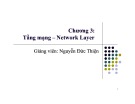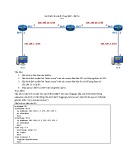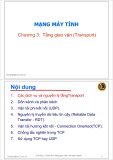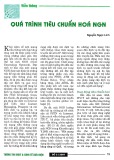
Anh-Thu Pham, Van-Nhan Nguyen, Tuan-Anh Pham, Thanh-Tra Nguyen
AN EFFICIENT EDGE-BASED PLANT
DISEASE DETECTION MODEL USES AN
ENRICHED DATASET AND DEEP
CONVOLUTIONAL NEURAL NETWORK
Anh-Thu Pham, Van-Nhan Nguyen, Tuan-Anh Pham, Thanh-Tra Nguyen
Telecommunications Faculty No1, Posts and Telecomms Ins of Technology Hanoi, Vietnam
Abstract–Crops and yields are significantly harmed by
plant diseases, one of agriculture’s most significant
problems. Researchers have recently investigated using
artificial intelligence (AI) to detect and effectively manage
disease early on to address this issue. This research focuses
on developing a method to optimize the DCNN (Deep
Convolutional Neural Network) classification model for
plant diseases. We enriched the data by incorporating data
from two public datasets, PlantVillage Dataset (PVD) and
CroppedPlant Dataset (CPD), and we trained the model
using two-step transfer learning. The experimental results
demonstrate that the model’s accuracy is 82%, more
significant than previous studies. Notably, achieving this
result with fewer parameters while maintaining adequate
performance compared to previous research demonstrates
the model’s efficient use of limited computing resources.
Hence, the proposed model is deployable on edge devices
to optimize availability and efficiency in real-world
environments and contribute to deploying new edge
computing and agriculture services.
Keywords– Leaf Diseases, Data Augmentation,
Transfer Learning, Edge Computing
I. INTRODUCTION
The impact of plant leaf diseases on crop quality and
production poses several challenges for agriculture today.
These diseases can cause significant crop damage,
reducing yields and quality while increasing production
and management costs. Artificial intelligence, specifically
image processing and deep learning techniques, can be
used to detect and identify leaf diseases, which is a
promising and practical solution [1] [2] [3].
Due to its convenience and efficiency, there is a
pressing need for an automatic and accurate method to
detect and identify plant leaf diseases [4]. Deep
convolutional neural networks (DCNNs) have emerged as
one of the most prevalent and effective deep learning
techniques in image processing [5]. DCNNs can learn and
apply sophisticated image features to tasks such as
segmentation, classification, recognition, and object
detection. In addition, deploying AI models on edge
computing devices is becoming an emerging approach in
5G and beyond for real-time and low-latency applications
[6].
Mixing datasets is an approach for increasing the
diversity of datasets and enhancing model generalization
[7] [8]. However, it may also occur in overfitting and
increased computational costs [9] [10]. To overcome these
challenges, we combine the PlantVillage Dataset (PVD)
dataset [11] with the Cropped PlantDoc dataset [12] to
enhance our diagnostic accuracy. In recent years, transfer
learning techniques, particularly the two-step transfer
learning approach, have demonstrated their effectiveness
in enhancing the performance of deep learning models [13]
[14]. This study uses a two-step transfer learning technique
to reduce the computational cost before putting the data
into our lightweight DCNN model (MobilenetV3large).
Our experimental results indicate that our proposed method
obtains better performance metrics than other state-of-the-
art studies. This paper is structured as follows. The
following section presents related work. Section 3
summarizes the characteristics of the two datasets utilized
in the model and the system’s overall architecture for
image-based disease diagnosis. Section 4 provides our
experimental results that compare the performance metrics
with other studies. The last section provides our
conclusions and future research directions.
II. RELATED WORK
Recent developments have been made in classifying
leaf images using AI models for plant disease
identification. Deep learning models for the PlantVillage
Dataset (PVD) dataset [11] have obtained extremely high
accuracy [15]. The constrained image capture conditions,
which are difficult to acquire in real life, are a limitation
of these models. Therefore, the Cropped PlantDoc (CPD)
dataset [12] containing various real-life images has a more
significant practical application. However, the efficiency
of AI methods on this dataset still needs to be improved.
The authors of [16] proposed kEffNet-B0, an enhanced
deep CNN model based on EfficientNet-B0 that achieved
64.39 percent accuracy. Another study [17] by the author
[16] using kEffNetB0- 32ch improved the accuracy better
[16] by 65.74%. In [12], the authors used
InceptionResNet-V2 with an accuracy of 70.53 percent.
With CPD dataset preprocessing, the authors [18] obtained
77% classification accuracy. The DCNN model in our
Contact author: Anh-Thu Pham,
Email: thupa@ptit.edu.vn
Manuscript received: 10/2023, revised: 11/2023, accepted:
12/2023.
SOÁ 04 (CS.01) 2023
TAÏP CHÍ KHOA HOÏC COÂNG NGHEÄ THOÂNG TIN VAØ TRUYEÀN THOÂNG 40

AN EFFICIENT EDGE-BASED PLANT DISEASE DETECTION MODEL USES AN ENRICHED DATASET AND …
previous work is quantized to be more suitable for edge
devices. Our model work utilizing a lightweight DCNN
(MobilenetV3Large) achieved approximately 78%
accuracy for multi-class CPD classification [19]. Despite
the use of some lightweight DCNN models that can be
deployed on edge devices, the efficacy of these models on
real-world image datasets still presents challenges,
according to these studies. Therefore, the main
contribution of this study is a new framework that
combines dataset mixing, transfer learning, and DCNN
techniques to increase the accuracy of plant disease
diagnosis in natural image datasets.
III. ENRICHING THE DATASETS
This section will present two popular data sets used
in the agricultural field. We enrich the datasets by mixing
natural data into the ideal data, called data preprocessing.
A. Data sets
Detecting plant diseases is an essential task in
agriculture but is still difficult because of the impacts of
environmental conditions. Computer vision technologies
have proven to be an effective tool for disease detection.
However, the different datasets used by different DCNN
models may produce different results. To demonstrate the
effectiveness of DCNN models, the models mentioned
above often use laboratory datasets (PlantVillage Dataset)
and real-life datasets (Croped- PlantDoc). Each data set has
its characteristics as well as its advantages and
disadvantages. Below, we will present the overview of
these two data sets.
PlantVillage Dataset [11]: Data sets used in agriculture
often require an extensive, validated database of photos of
healthy and damaged plants to develop accurate image
classifiers for diagnostic applications of plant diseases.
Such a dataset did not exist until recently, and even smaller
datasets are not publicly accessible. To address this
problem, the PlantVillage Dataset project initiated the
collection of thousands of images of healthy and diseased
plants that were freely accessible to the public. All images
in the PlantVillage Dataset database were taken at
experimental research stations and laboratories, with
various brightness, environment, and other user-specified
settings. Finally, the end devices (smartphone users) will
take pictures in various” random” conditions. Figure 1
shows an example of potato images in the Planvillage
dataset.
More than 50,000 images in the Planvillage dataset are
currently hosted on the website www.PlantVillage
Dataset.org, and this dataset can be accessed through US
universities (Penn State, Florida State, Cornell, and others).
The dataset contains 54,303 images of healthy and
unhealthy leaves, classified into 38 categories based on
species and disease. Plants such as Apples, Blueberries,
Cherries, Corn, Grapes, Oranges, Peach, Bell Peppers,
Potatoes, Raspberries, Soybeans, Pumpkins, Strawberries,
and Tomatoes are all included in that dataset. In addition,
illustrations of 17 fungal diseases, four bacterial diseases,
two mold diseases (oomycetes), two viral diseases, and one
tick-borne disease are also shown in that dataset. There are
images of healthy leaves on 12 disease-free plant species,
and the total number of classes in the dataset is 38.
Fig. 1. Some of the plant diseases from the PlantVillage
Dataset
The Cropped-PlantDoc dataset [12]: Singh and his
collaborators created the Cropped-PlantDoc dataset
containing 13 plant species and 27 classes. Similar to the
Plant Village dataset, the original PlantDoc dataset
includes an image of each leaf. However, those images also
show the complex background and the area covered by the
different target leaves, which makes classification much
more difficult than the PlantVillage Dataset images. The
authors manually crop the image regions containing the
target leaves to address this shortcoming. This produces
conveniently framed leaves while greatly increasing the
number of samples (approximately 9K) as several samples
from each original PlantDoc image can be extracted
(approximately 2.6K). Figure 2 presents some examples of
leaf images in the PlantDoc Dataset.
Fig. 2. Example images of CPD and PVD
B. Data preprocessing
As mentioned at the beginning, we combine two
datasets in this paper: laboratory dataset (PVD) and
naturally collected dataset (CPD). However, there is a
problem with the number of classes in the two datasets; that
is, the PVD dataset has 38 classes, but the CPD dataset has
only 27 classes. Since the 27 classes in the CPD dataset are
all included in the PVD dataset, and this study aims to
make the model deployable in practice, we will test the
model performance on the combined CPD dataset and 27
of the 38 classes of the PVD dataset. After combining, the
new dataset will have 27 classes similar to the CPD dataset.
This study combines two datasets, including PVD and
CPD, as illustrated in Figure 3. First, the PVD dataset is
randomly divided into two subsets: PVD train and PVD
val. This division is performed in three different cases with
the division ratios of 80:20, 70:30, and 50:50, respectively.
Similarly, the CPD dataset is randomly divided once to
SOÁ 04 (CS.01) 2023
TAÏP CHÍ KHOA HOÏC COÂNG NGHEÄ THOÂNG TIN VAØ TRUYEÀN THOÂNG 41

Anh-Thu Pham, Van-Nhan Nguyen, Tuan-Anh Pham, Thanh-Tra Nguyen
form three subsets: CPD train, CPD val, and CPD test, with
a ratio of 65:15:20.
The data merging process is applied only during the
training and validation phases. When conducting the final
model testing, we focus on the more complex dataset, i.e.,
the CPD dataset. We perform the matching in pairs: CPD
train is combined with the PVD train, CPD val is combined
with PVD val, and the CPD test is kept intact. The result of
this combination creates a dataset called ’Combine data,’
consisting of three cases corresponding to three PVD split
ratios: Combine data 1, Combine data 2, and Combine data
3. Each of these combined data consists of three subsets of
data, which are used for training, validation, and testing,
respectively. By comparing and analyzing the model’s
results on each of the three PVD dataset division ratios, we
would like to determine our model’s most optimal
partitioning case.
Fig. 3. The combined dataset of the CPD and PVD
In addition, data augmentation is also applied before
feeding the training model. The augmentation techniques
used include Randomly Flipping the images horizontally,
Randomly rotating images with a maximum angle of 30
degrees, Randomly zooming the images with a maximum
factor of 30%, and Changing the contrast of the images
with a maximum factor of 30%.
IV. THE PROPOSED MODEL AND RESULTS
A. The proposed DCNN model
In this paper, we use the MobilenetV3Large model in
the previous study [19], and there are some changes in
model training. The MobilenetV3 model has two variants,
including MobileNetV3-Small and MobilenetV3-Large.
These two variants have the same architecture and only
differ in the number of parameters. Transfer learning in
image processing has improved with time, identifying
efficient kernels/filters or models. These well-known pre-
trained models use the knowledge gained from training on
thousands of objects in the ImageNet dataset, the largest
repository of its kind. Integrating a pre-trained model with
ImageNet into a framework uses kernels that match leaf
properties as a starting point. This method uses verified and
correct knowledge to fine-tune kernels that may not match
plant ingredients.
Our pre-training uses a MobileNetV3Large extractor to
extract features from the input Imagenet dataset (Figure 4).
The initial weight of the extractor is learned from the
dataset. Then, we add a ’global average pooling2d’ layer to
reduce the output size of the network and, at the same time,
retain the image feature after extraction. In addition, the
’dropout’ layer is added after the ’global average
pooling2d’ layer to prevent over-matching. Finally,
MobileNetV3’s extractor is retrained on the combined
dataset to update the original weight of the extractor.
Fig. 4. Pre-training feature extractor
At the end of pre-training, the model will be finetuned.
The output of the global average pooling2d class will be
extracted. This helps us obtain the extracted image’s
feature after passing through the extractor for further
classification processing. After the extractor is pre-trained,
the DNN classifier is placed at the extractor output.
Precisely, 4 Dense classes with the number of nodes 512,
512, 128, 128, and 27 correspond to 27 classes in the
dataset, using the activation function “Relu.” They are
placed after the ’dropout’ layer in the extractor, as shown
in Figure 5. The final model has 3.8 million parameters,
and finetuning is done with this new model. During the
finetuning process, we finetuned the model on the dataset
with only CPD data by only updating the classifier’s
parameters. The previous layers in the feature extractor
will be frozen. The final model validation and testing
processes will also be performed on the CPD dataset.
Fig. 5. The proposed training model with pre-trained
extractor and DNN classifier
B. Training results
Our experiment is implemented in Python 3.7 with the
TensorFlow framework and Keras library for Deep
Learning tasks. Experiments were performed on a
computer featuring an Intel ® Core i9 10900K, a Nvidia®
RTX A4000 GPU, and 48 GB RAM. We train to achieve
the best model with the following training results. After
Fig. 6. Accuracy of the model on three sets
of Combine Data
SOÁ 04 (CS.01) 2023
TAÏP CHÍ KHOA HOÏC COÂNG NGHEÄ THOÂNG TIN VAØ TRUYEÀN THOÂNG 42

AN EFFICIENT EDGE-BASED PLANT DISEASE DETECTION MODEL USES AN ENRICHED DATASET AND …
training, the model results on 3 cases of the Combine data
are presented in Figure 6.
As shown in Figure 6, the model could achieve the
highest accuracy with the dataset of Combine data 1, which
corresponds to dividing the data in the PVD set with a ratio
of 80:20. Since the model achieves the best accuracy on
Combine data 1, in the next section, we will select the
results of the model on this dataset to compare with the
results of the other authors. Figure 7 shows the results of
the extractor training and validation.
The accuracy graph shows that the training process
took place smoothly in the first ten epochs, so the model
learned from about 70% up to 96%. After those ten epochs,
the training accuracy increased slightly and stabilized at
98%. Likewise, validation accuracy after ten epochs also
starts to stabilize around 96%.
Similar to the Accuracy graph, the Loss graph in 8
during model training also quickly reached the optimal
level after ten epochs. After the 10th epoch, the loss of both
the training and validation processes decreased slightly and
stabilized. Moreover, after 50 epochs, both the Accuracy
and Loss of the model have reached the learning threshold.
Fig. 7. Accuracy of training and validation
Fig. 8. Loss of training and validation
C. Parameters and comparison results
In this section, we compare the previously studied
DCNN models in terms of parameters and accuracy. The
specific results related to the model parameters and the
model accuracy given by the authors mentioned in part II
are shown in Table I.
Table 1: A comparison of the dcnn model in terms of
parameter and accuracy
Model
Year
Parame
ters
Accurac
y
EfficientNet [16]
2021
664K
64.39%
kEffNet-B0 32ch [17]
2022
1.08M
65.74%
InceptionResNetV2 [12]
2020
“
70.53%
Color-Aware Two-Branch
[18]
2022
5M
76.91%
MobilenetV3-Large [19]
2022
5M
77.71%
The results in Table I have shown that the model
proposed by the authors in [16] has the lowest number of
parameters of 664K, leading to the model’s accuracy only
stopping at 64.39%. In addition to optimizing the number
of parameters to deploy on edge devices, accuracy must
also be ensured at a reasonable level. Our previous study
[19] achieved an accuracy result of 77.71%, higher than
that of previous authors. Specifically, the accuracy result
given by the authors in [18] is 76.91% when having the
same number of model parameters. In this study, we
continue to improve the model’s accuracy and number of
parameters to compare it with our previous study [19].
Table 2: Comparison of the proposed model with the
previous model
Model
Parameters
Accuracy
F1-Score
MobilenetV3larg
e [19]
5M
77.71%
0.7723
Proposed Model
3.8M
82.01%
0.8194
The comparison results between the proposed model in
this paper and the proposed model in the previous study are
described in Table II. The model proposed in this article
has achieved better parameters, accuracy, and F1 score
than the previous model. Specifically, the accuracy of the
proposed model is 5% better than previous research [19].
Next, the F1- Score of this model is also higher than that of
the previous study. In addition, the number of parameters
of the proposed model is also focused on when developing
the model on edge devices. The model in this study
achieves higher accuracy and requires fewer parameters
than in previous studies. The fact that the proposed model
achieves a testing accuracy of about 82% while training
accuracy reaches 98% might be worth considering. The
difference in the training dataset and testing dataset can
explain the cause. We use a combined dataset during
training, including the laboratory and real-life datasets.
Training datasets from the laboratory can be simple and
give better results, so the accuracy in this process is usually
higher. However, it is easy to see that the real-life dataset
in the combined dataset is less than the data from the
laboratory. This can lead to high accuracy during training
that does not accurately reflect the model’s ability for real-
life data. When we conduct model testing, we only use real-
life datasets, which requires the model to deal with real-life
images with more complex backgrounds than those in the
lab. This can significantly reduce the model’s accuracy
compared to the training process.
V. CONCLUSION
This paper presents a methodology for enhancing
input data and a transfer learning approach for a DCNN
model dedicated to plant leaf disease classification. We
executed a two-step transfer learning method at varying
proportions by combining two publicly available datasets, PVD
and CPD. In this process, the initialization parameters of the
feature extractor were transferred from Imagenet.
Subsequently, we trained the feature extractor on the
combined dataset and applied transfer learning to the final
model with a DNN classifier for finetuning. The outcome
is constructing a training model requiring fewer parameters
for deployment on edge devices. Experiment results have
demonstrated that our approach significantly improves the
SOÁ 04 (CS.01) 2023
TAÏP CHÍ KHOA HOÏC COÂNG NGHEÄ THOÂNG TIN VAØ TRUYEÀN THOÂNG 43

Anh-Thu Pham, Van-Nhan Nguyen, Tuan-Anh Pham, Thanh-Tra Nguyen
accuracy of plant leaf disease classification while
maintaining efficiency in model parameter utilization. Our
methodology holds potential for practical applications,
such as aiding farmers in disease detection and control.
Furthermore, we anticipate that our method will stimulate
other researchers to explore novel machine-learning
techniques to address real-world agricultural challenges.
REFERENCES
[1] Jo´zsef Popp, Ka´roly Peto˝, and Ja´nos Nagy. Pesticide
productivity and food security. a review. Agronomy for
sustainable development, 33:243– 255, 2013.
[2] Smriti Sharma, Rubaljot Kooner, and Ramesh Arora. Insect
pests and crop losses. Breeding insect resistant crops for
sustainable agriculture, pages 45–66, 2017.
[3] Jun Liu and Xuewei Wang. Plant diseases and pests
detection based on deep learning: a review. Plant Methods,
17:1–18, 2021.
[4] Jun Liu and Xuewei Wang. Plant diseases and pests
detection based on deep learning: a review. Plant Methods,
17:1–18, 2021.
[5] Neena Aloysius and M Geetha. A review on deep
convolutional neural networks. In 2017 International
Conference on Communication and Signal Processing
(ICCSP), pages 0588–0592. IEEE, 2017.
[6] Jiasi Chen and Xukan Ran. Deep learning with edge
computing: A review. Proceedings of the IEEE,
107(8):1655–1674, 2019.
[7] Connor Shorten, Taghi M Khoshgoftaar, and Borko Furht.
Text data augmentation for deep learning. Journal of big
Data, 8:1–34, 2021.
[8] Jiageng Mao, Shaoshuai Shi, Xiaogang Wang, and
Hongsheng Li. 3d object detection for autonomous driving:
A comprehensive survey. International Journal of Computer
Vision, pages 1–55, 2023.
[9] Hongyi Zhang, Moustapha Cisse, Yann N Dauphin, and
David Lopez- Paz. mixup: Beyond empirical risk
minimization. arXiv preprint arXiv:1710.09412, 2017.
[10] Connor Shorten and Taghi M Khoshgoftaar. A survey on
image data augmentation for deep learning. Journal of big
data, 6(1):1–48, 2019.
[11] Faye Mohameth, Chen Bingcai, and Kane Amath Sada.
Plant disease detection with deep learning and feature
extraction using plant village. Journal of Computer and
Communications, 8(6):10–22, 2020.
[12] Davinder Singh, Naman Jain, Pranjali Jain, Pratik Kayal,
Sudhakar Kumawat, and Nipun Batra. Plantdoc: A dataset
for visual plant disease detection. In Proceedings of the 7th
ACM IKDD CoDS and 25th COMAD, pages 249–253.
2020.
[13] Guangzhou An, Hideo Yokota, Naohiro Motozawa, Seiji
Takagi, Michiko Mandai, Shohei Kitahata, Yasukiko
Hirami, Masayo Takahashi, Yasuo Kurimoto, and Masahiro
Akiba. Deep learning classification models built with two-
step transfer learning for age-related macular degeneration
diagnosis. In 2019, the 41st Annual International Conference
of the IEEE Engineering in Medicine and Biology Society
(EMBC), pages 2049–2052, IEEE, 2019.
[14] Ruochi Zhang, Zhehao Guo, Yue Sun, Qi Lu, Zijian Xu,
Zhaomin Yao, Meiyu Duan, Shuai Liu, Yanjiao Ren, Lan
Huang, et al. Covid19xraynet: a two-step transfer learning
model for the COVID-19 detecting problem based on a
limited number of chest x-ray images. Interdisciplinary
Sciences: Computational Life Sciences, 12:555–565, 2020.
[15] Raj Kumar, Anuradha Chug, Amit Prakash Singh, and
Dinesh Singh. A systematic analysis of machine learning
and deep learning based approaches for plant leaf disease
classification: a review. Journal of Sensors, 2022, 2022.
[16] M Villaret et al. Grouped pointwise convolutions
significantly reduce parameters in an efficient net. In
Proceedings of the 23rd International Conference of the
Catalan Association for Artificial Intelligence, IOS Press,
volume 339, page 383, 2021.
[17] Joao Paulo Schwarz Schuler, Santiago Romani, Mohamed
Abdel-Nasser, Hatem Rashwan, and Domenec Puig.
Grouped pointwise convolutions reduce parameters in
convolutional neural networks. In Mendel, vol- ume 28,
pages 23–31, 2022.
[18] Joao Paulo Schwarz Schuler, Santiago Romani, Mohamed
Abdel-Nasser, Hatem Rashwan, and Domenec Puig. Color-
aware two-branch DCNN for efficient plant disease
classification. In MENDEL, volume 28, pages 55–62, 2022.
[19] Hoang Trong Minh, Tuan Pham Anh, et al. A novel
lightweight DCNN model for classifying plant diseases on
Internet of things edge devices. In MENDEL, volume 28,
pages 41–48, 2022.
MỘT MÔ HÌNH PHÁT HIỆN SÂU BỆNH HIỆU
QUẢ TẠI BIÊN MẠNG SỬ DỤNG TẬP DỮ LIỆU
LÀM GIẦU VÀ MẠNG NƠ RON TÍCH CHẬP
Tóm tắt- Cây trồng và sản lượng bị tổn hại đáng kể do
bệnh cây trồng, đây là một trong những vấn đề nghiêm
trọng nhất của nông nghiệp. Các nhà nghiên cứu gần đây
đã nghiên cứu sử dụng trí tuệ nhân tạo (AI) để phát hiện và
quản lý bệnh sớm một cách hiệu quả nhằm giải quyết vấn
đề này. Nghiên cứu này tập trung phát triển phương pháp
tối ưu hóa mô hình phân loại DCNN (Deep Convolutional
Neural Network) đối với bệnh cây trồng. Chúng tôi đã làm
phong phú dữ liệu bằng cách kết hợp dữ liệu từ hai bộ dữ
liệu công khai, Bộ dữ liệu PlantVillage (PVD) và Bộ dữ
liệu CroppedPlant (CPD) và chúng tôi đã đào tạo mô hình
bằng cách sử dụng phương pháp học chuyển giao hai bước.
Kết quả thực nghiệm chứng minh độ chính xác của mô hình
là 82%, cao hơn nhiều so với các nghiên cứu trước đây.
Đáng chú ý, việc đạt được kết quả này với ít tham số hơn
trong khi vẫn duy trì hiệu suất phù hợp so với nghiên cứu
trước đây chứng tỏ mô hình sử dụng hiệu quả các tài
nguyên tính toán hạn chế. Do đó, mô hình đề xuất có thể
triển khai trên các thiết bị biên để tối ưu hóa tính khả dụng
và hiệu quả trong môi trường thế giới thực, đồng thời góp
phần triển khai các dịch vụ nông nghiệp và điện toán biên
mới.
Từ khoá- Bệnh lá, Tăng cường dữ liệu, Học chuyển
giao, Điện toán biên.
Anh-Thu Pham received B.E degree of
Telecommunication engineering from
Posts and Telecommunications Institute of
Technology (PTIT), Viet Nam, in 2003,
and M.E degree of Telecommunication
engineering from Royal Melbourne
Institute of Technology, Australia, in 2008.
She received the Ph.D. degree in
Telecommunication engineering from
PTIT, in 2010. Now, she is a lecturer in
Telecommunication faculty of PTIT. Her
research interests include networking,
radio over fiber, and broadband networks..
Email: thupa@ptit.edu.vn
SOÁ 04 (CS.01) 2023
TAÏP CHÍ KHOA HOÏC COÂNG NGHEÄ THOÂNG TIN VAØ TRUYEÀN THOÂNG 44




















![Đề thi cuối kì Nhập môn Mạng máy tính: Tổng hợp [Năm]](https://cdn.tailieu.vn/images/document/thumbnail/2025/20251110/nminhthoi53@gmail.com/135x160/38281762757217.jpg)



![Đề thi học kì 2 môn Nhập môn Mạng máy tính [kèm đáp án]](https://cdn.tailieu.vn/images/document/thumbnail/2025/20251014/lakim0906/135x160/23811760416180.jpg)

